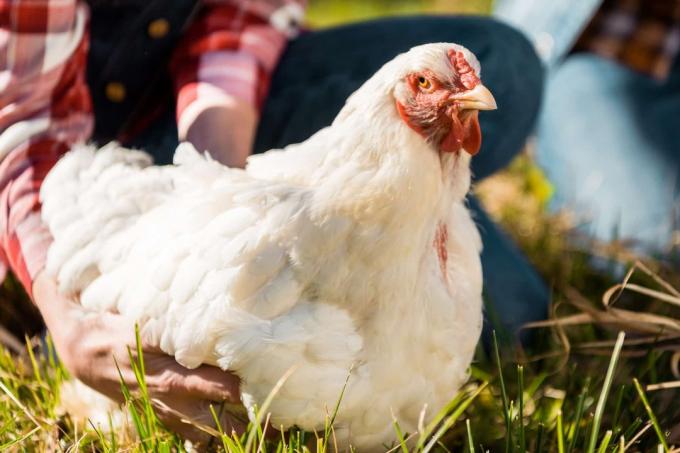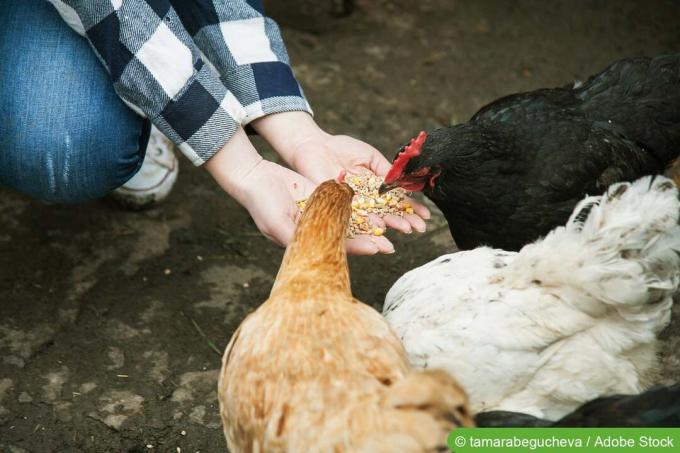

Table of contents
- injuries
- joint problems
- Bacterial infection and parasitic infestation
- Marek's disease
- nutrient deficiency
- frequently asked Questions
A chicken is more likely to become unable to walk, limp, weak on its feet, or sag its hindquarters. Then you need to research the cause in order to be able to react correctly.
injuries
If the chicken suddenly stops walking or limps badly, the cause may be an injury. This can be the case, for example, when getting caught in a fence, by an attack from a Fox or other predators as well as through fights with other chickens. Pain, swelling and fractures then prevent the chicken from walking.
Act right

Examine the affected chicken quickly for possible injuries. In addition to the extremities, also look at the hips and buttocks, because that's where the extended "treadmills" and tendons reach. If you recognize a wound, the right action depends on the type of injury:
| Type of injury | Treatment |
|---|---|
| Severe sensitivity to touch with severe swelling, possibly an open wound and deformity of the affected extremity | visit the veterinarian quickly for clarification and treatment of a possible fracture |
| superficial wound | Clean with isopropanol several times a day |
| Clean with isopropanol several times a day | wait a maximum of two days, observe swelling and walking behavior at shorter intervals; no improvement, consult a veterinarian |
| deep, gaping wound | to the vet for stitches to prevent infection |
In any case, you should immediately isolate the affected animal.
Tip:
You can tell if a chicken is in pain by the trembling of the head and neck, convulsions, signs of paralysis and rowing of the legs when lying on its side. The more intense the characteristics are, the more sensible it is to make representations to the veterinarian.
joint problems
Sprains and joint osteoarthritis, especially in older animals, are more common in chickens. The chicken has pain when moving, limping or not being able to walk at all. Osteoarthritis of the joint can also affect the hip, which means that the animal can no longer put the leg on the affected side down, or can only do so with pain. A sprain is often accompanied by a slight swelling, but it doesn't have to be.
Act right

If there is arthrosis in the joints, palpation of the joints can provide an indication. Some of the joints are slightly swollen and the chickens are sensitive to pain when they are gripped tightly. If this is the case, you should visit the veterinarian so that he can confirm the diagnosis and start a promising treatment and/or at least relieve the pain. Insulation and a dry barn are important now.
A sprain usually hurts the area around a joint because it primarily affects the ligaments and tendons, making the chicken appear weak on its feet. Now the animal needs rest, which is why you should keep it protected and isolated from its own kind and everything else that is exciting. A sprain usually resolves on its own within a few days.
Bacterial infection and parasitic infestation
The most common causes of lameness in chickens include internal inflammation and parasitic infestation. Especially worms and the mites are widespread. Inflammation leading to lameness is mainly found in the ovaries. Running movements can cause this severe pain, causing the chickens to relax and hang their limbs as if paralyzed.
Act right
Infections and parasite infestations must be treated quickly because they can cause life-threatening situations if left untreated. It is therefore important to recognize the first suspicions of a disease and to contact the doctor for effective countermeasures.
The following abnormalities can indicate a disease and a parasite infestation:
- weak on his feet, general listlessness and disinterest
- decreased appetite
- changed behavior
- Spring picking or increased spring failure
Marek's disease

Source: Lucyin, Maladeye Marek pate sitindowe divant, Edited by Home Garden, CC BY-SA 3.0
Marek's disease is a virus that primarily affects chicks and young chickens up to about five months of age. The disease usually ends fatally. Only tough, tough chickens stand a chance of surviving them.
The viral disease manifests itself as follows:
- Signs of paralysis in the hind limbs
- possibly blindness and/or pupillary changes
- raised legs or limp when walking
- completely uncoordinated movement sequences possible
- in the later stage of the disease, swellings can be felt on the legs
- unusual skin changes appear in chicks from the fifth or sixth week of life
- other distinguishing features can only be determined by a veterinarian, as they relate to internal organs
Act right
There is currently no therapy for Marek's virus disease. Very weak and suffering chickens should be relieved quickly. Subsequent disinfection of the stable and enclosure is important in order to kill the virus, which can survive without a host for over a year and infect other chickens. At the same time, the conspecifics should be vaccinated against the virus immediately, because this is the only way to protect the population through prevention.
A notice:
A simple disinfection is not sufficient for this herpes virus disease. This must be done precisely and special virus-killing disinfectants must be used. Consultation with a veterinarian is highly recommended.
nutrient deficiency
Chickens have specific nutritional needs that need to be met. Otherwise, deficiency symptoms occur, which can manifest themselves in lameness and problems with walking and standing. A lack of vitamins C and D in particular can lead to bone and joint problems, which can go so far that the chicken can no longer walk properly.
Act right

Check the feed and the feed behavior in terms of ration and nutrients. You have to react when the affected chicken receives far too little feed, for example because other dominant and greedy chickens keep it away or you offer nutrient-poor feed:
- feed displaced chickens in separate areas
- Exchange low-nutrient feed for a balanced diet
- rely on vitamins C and D as well as lime and special chicken vitamins
We also recommend checking with a veterinarian.
frequently asked Questions
Yes, by severing the head with an ear slit or an axe. Care must be taken to ensure that this is done in a professional manner so that the animal does not suffer torture that is prohibited and punishable by law. Euthanasia can only be done by a veterinarian.
That is different. It can vary from region to region and also depends on the weight of the chicken away. As a rule, the cost of euthanizing a chicken is between eight and 25 euros.
It depends on the condition and whether the chicken has been given any medication. It is generally not advisable to eat chickens with bacterial or viral diseases. In the case of previous administration of medication, a waiting period must often be observed or consumption avoided entirely. Here the vet clarifies. If the only cause of death is injury, without the use of medication, the chicken is edible.
 Mirko
Mirko
Learn more about pets

Common chicken diseases with symptoms + pictures
Chickens are low-maintenance animals, but they are not immune to diseases. Parasites, viruses or bacteria can cause them problems and serious illnesses are even notifiable. Here you will find the most common chicken diseases with symptoms and pictures at a glance.

Chicken twists its head: what does that mean?
When chickens suddenly tilt their heads, there is usually a serious reason behind it. Here you can find out what can be responsible and what action should be taken if a chicken turns its head.

Chicken tilts to the side: balance disorder?
Keeping chickens in your own garden is becoming increasingly popular. All you need is enough exercise and a winter-proof stable. Unfortunately, chickens are not the most robust creatures. For example, if a chicken repeatedly falls to the side, it can be due to an imbalance, but it can also be worse.

Bird Names: 348 Popular Budgie Names
If you have budgies as pets or are planning to get two parakeets, the exciting task ahead of you is naming them appropriately. In this text you will be presented with various budgie names to help you choose of a name that suits both your feathered friend and your personal taste fits.

441 guinea pig names from cute to funny
A suitable guinea pig name can not only be a fun or cute addition, but also a way to create a special bond with your little furry friend.

Turtle Names: 473 Names for Turtles
Finding an appropriate name for your turtle can be a fun and meaningful task. A well-chosen turtle name can underline your friend's personality and uniqueness and create a special bond between the two of you. Whether you're looking for male, female, or gender-neutral names, you'll find a wide range of names for your […]

